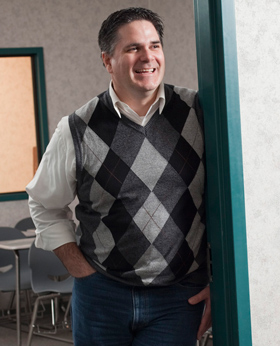Lake Elsinore USD’s Virtual Learning Center Helps Students Turn F’s into A’s
If Nathan Scott's students feel like texting during school, he's OK with it. If they want to listen to their music or take calls, it's no problem. They work when they feel like it, and they stop when they're ready to call it quits.
Scott, a math teacher in the Lake Elsinore (Calif.) Unified School District, isn't obsessively vying for the title of World's Coolest Teacher. He and his colleagues simply tell students that they're in charge of their own learning, which means they get to decide when, where and under what circumstances they study.
Scott is one of four teachers in the district's Virtual Learning Center, a program that allows students from any of LEUSD's three high schools or its K–12 charter school, the Southern California Online Academy (SCOA), to retake online the courses they failed in a traditional classroom setting. The VLC also offers first-time courses in health and driver's education, as well as high school courses for advanced middle school students.
640 The maximum enrollment at Lake Elsinore Unified School District's Virtual Learning Center
The program gives area students greater access to courses with more flexibility in an alternative format, and because the courses are online, students can take as much or as little time as they need to learn the material. What's more, students can do their work at home, in their school libraries or at the VLC's brick-and-mortar site. The only time they have to see their teachers, in fact, is when they're taking tests at the VLC lab. "They barely have to see us if they don't want to," Scott says.
VLC staff make themselves available to students who want help with the course material, however. The teachers spend one day a week at each of the high schools and a fourth day at the VLC lab.
"It's completely different from a classroom setting because the kid's driving it," Scott explains. A student might not be ready to engage in geometry concepts first thing in the morning, for example, but if his class is at 8 a.m., he doesn't have a choice — and that can lead to discipline problems. But, says Scott, "there have never been any discipline issues at the VLC because the kids want to be here. They come in 100 percent focused, and they do their work."
Easy Does IT
What's amazing about a program that's had such a positive effect on the LEUSD community is that it was so easy to establish, says Director of IT Services J.R. Rea. Asked if there were any challenges, he responds: "Actually, no. We were very pleased with the deployment."
When the VLC opened in 2009, an IT staff person was on call each day from noon to 3 p.m., but he soon grew bored. The equipment and platform were so straightforward that students and teachers didn't run into many problems. Now, the IT technician goes to the VLC only when needed. "It's getting to be a 'set it and forget it' operation," Rea says.
The VLC is housed in a building constructed just 10 years ago, so it had sufficient data and power from the start. One of the IT team's goals was to configure devices in such a way that they could guarantee 99.999 percent uptime with minimal maintenance. Instead of putting fat clients in the VLC, they chose NComputing thin clients. That way, there's only one computer to worry about; the rest are simply screens, keyboards and mice.

Photo: Stephanie Diani
"[Filtering technology] helps us keep tabs on what's going on," Rea says.
The IT team also wanted to ensure that VLC equipment adhered to the district's security policies, so they used filtering technologies, which separate the devices connected to the fat client. Without the filter, if a teacher logged in to the fat client, all students using the thin clients would be logged in with the teacher's same credentials. But with it, each student logs in to his or her own workstation. "It helps us keep tabs on what's going on," Rea says.
IT staff also recently completed a major Aruba Networks–based wireless rollout on the campus where the VLC is located — a move that Rea expects will push the already successful project to another level.
Online Learning Is a Real Class Act
Hunched in the back row of a 33-student classroom, a skinny kid timidly raises his hand. "I'm just not getting this whole algebra thing," he says when the teacher calls on him. "Can you start from the beginning?"
Clearly, this is a fictional scenario. Teachers don't have the luxury of starting over or speeding up the curriculum to accommodate one student. But with online learning, the teacher doesn't set the pace — each student does, says Ryan Mulvanny, VLC administrator and principal of the SCOA charter school.
The VLC, along with the rest of the district, uses a web-based learning management system that divides courses into modular units, each of which consists of video tutorials, offline activities, practice problems and quizzes. If students know the material, they can just take the quiz and move on to the next module. But if they're struggling, they can review the videos, activities and problems as often as they need.
Students can meet with, call or e-mail the teacher if they need additional help, according to Dr. Alain Guevara, LEUSD's assistant superintendent of instructional support services. Many students prefer the one-on-one contact with their teachers, he says, because they can ask questions privately instead of in front of a room full of students.
The learning management system's manufacturer developed the coursework, but teachers can modify the curriculum as needed. Scott says most of the courses, which are taught using the flipped-classroom approach, are strong enough that they don't need to be altered.
"It's a really good program," Scott says. Having students learn the material on their own time, then practice it with the help of teachers, is "the way education's going."
Moving Beyond the Book
Lake Elsinore Unified School District created its Virtual Learning Center in fall 2009. "It was the first step in finding new ways to reach all students," says Dr. Alain Guevara, LEUSD's assistant superintendent of instructional support services. Last year, the district continued in that direction by opening the Southern California Online Academy, a K–12 charter school with a full-time blended learning program.
Online education isn't for everyone, however. As Guevara points out, students need to be independent learners. For those willing to accept the responsibility, online courses offer a lot more flexibility than do traditional classes.
In addition to the coursework, online learning teaches students to take initiative. In a traditional classroom, students are used to simply following the rules in a completely structured setting, Guevara continues. But with online learning, they're working on their own schedules and taking charge of the process.
"When it's not tied to attendance — but rather, achievement — they're rolling through it," says Ryan Mulvanny, administrator of the VLC and principal of SCOA. That, he says, more closely mirrors the workplace. "When you go to a job, you don't get paid to just show up. You're expected to produce something."







